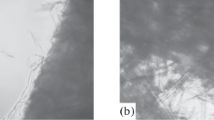Abstract
Selection of high-producing cell lines is an important strategy in developing methods for the industrial production of useful secondary metabolites by cultured plant cells (1,2). Between and within cell lines considerable differences exist in production levels of secondary metabolites. These differences can be attributed either to phenotypical variation or to somaclonal variation. Phenotypical variation — e.g. due to cellular differentiation, extended exposure to various plant growth hormones or variations in environment — is reversible and will not result in a stable high-producing cell line. It is more likely that somaclonal variation will be a source of stable high-producing variants or mutants, especially when additional mutagenic treatments are imposed.
Access this chapter
Tax calculation will be finalised at checkout
Purchases are for personal use only
Preview
Unable to display preview. Download preview PDF.
Similar content being viewed by others
References
Deus, B., and M.H. Zenk (1982). Biotechn Bioeng. 24: 1965–1974.
Wersuhn, G. (1988). Biochem. Physiol. Pflanzen 183: 361–369.
Harkins, K.R., and D.W. Galbraith (1984). Physiol. Plant. 60: 43–52.
Brown, S., J.-P. Renaudin, C. Prévot and J. Guern (1984). Physiol. Vég. 22: 541–554.
Deus-Neumann, B, and M.H. Zenk (1984). Planta Med. 50: 427–431.
Hara, Y., H. Yamagata, T. Morimoto, J. Hiratsuka, T. Yoshioka, Y. Fujita and Y. Yamada (1989). Planta Med. 55: 151–154.
Brown, S. (1984). Physiol. Vég. 22: 341–349.
Galbraith, D.W., C.L. Afonso and K.R. Harkins (1984). Plant Cell Rep. 3: 151–155.
Ketel, D.H. (1988). Planta Med. 5: 400–405.
Binding, H., R. Nehls, R. Kock, J. Finger and G. Mordhorst (1981). Z. Pflanzenphysiol. 101: 119–130.
Dougall, D.K., J.M. Johnson and G.H. Whitten (1980). Planta 149: 292–297.
Author information
Authors and Affiliations
Editor information
Editors and Affiliations
Rights and permissions
Copyright information
© 1990 Kluwer Academic Publishers
About this chapter
Cite this chapter
Adamse, P. (1990). Selection of High-Yielding Cell Lines of Tagetes Using Flow Cytometry. In: Nijkamp, H.J.J., Van Der Plas, L.H.W., Van Aartrijk, J. (eds) Progress in Plant Cellular and Molecular Biology. Current Plant Science and Biotechnology in Agriculture, vol 9. Springer, Dordrecht. https://doi.org/10.1007/978-94-009-2103-0_109
Download citation
DOI: https://doi.org/10.1007/978-94-009-2103-0_109
Publisher Name: Springer, Dordrecht
Print ISBN: 978-94-010-7445-2
Online ISBN: 978-94-009-2103-0
eBook Packages: Springer Book Archive




